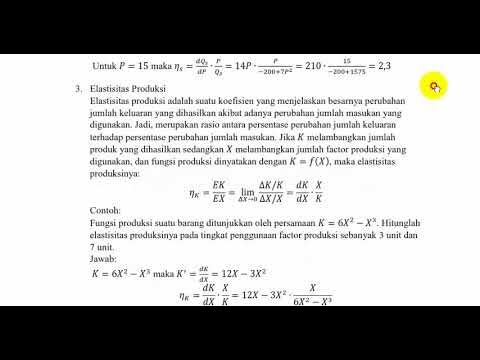Elasticity (Elastisitas). Ed?, Es? "Microeconomics"
Summary
TLDRThis video explains the concepts of elasticity of demand and elasticity of supply. It defines elasticity as the percentage change in price relative to the percentage change in quantity demanded or supplied. The video discusses various types of demand elasticity, including elastic, inelastic, unitary, perfectly elastic, and perfectly inelastic demand, as well as factors that influence these elasticities, such as substitute availability, income percentage, and product nature. It also covers supply elasticity types and factors like production costs, time, technology, and the number of producers. The video concludes with formulas to calculate the elasticity of demand and supply.
Takeaways
- 😀 Elasticity measures the responsiveness of quantity demanded or supplied to price changes.
- 😀 Elasticity of demand is determined by the percentage change in price relative to the percentage change in quantity demanded.
- 😀 There are five types of elasticity of demand: elastic, inelastic, unitary elastic, perfectly elastic, and perfectly inelastic.
- 😀 Elastic demand (Ed > 1) occurs when the percentage change in quantity demanded is greater than the percentage change in price.
- 😀 Inelastic demand (Ed < 1) happens when the percentage change in quantity demanded is smaller than the percentage change in price.
- 😀 Unitary elastic demand (Ed = 1) is when the percentage change in quantity demanded equals the percentage change in price.
- 😀 Perfectly elastic demand (Ed = ∞) means a tiny price change results in an infinite change in quantity demanded.
- 😀 Perfectly inelastic demand (Ed = 0) means price changes have no effect on the quantity demanded.
- 😀 The factors influencing elasticity of demand include the availability of substitutes, the proportion of income spent, the time frame for decision-making, and whether the good is a luxury or necessity.
- 😀 Elasticity of supply measures how the quantity supplied responds to price changes and is similarly categorized as elastic, inelastic, unitary elastic, perfectly elastic, or perfectly inelastic.
Q & A
What is elasticity in economics?
-Elasticity refers to the responsiveness of quantity demanded or supplied to changes in price. It measures how much the quantity of a good changes when the price changes, expressed as a percentage change in quantity relative to a percentage change in price.
What does the term 'elasticity of demand' mean?
-Elasticity of demand refers to how sensitive the quantity demanded of a good is to a change in its price. It is calculated as the percentage change in quantity demanded divided by the percentage change in price.
What are the different types of demand elasticity?
-The types of demand elasticity include: 1) Elastic demand (Ed > 1), 2) Inelastic demand (Ed < 1), 3) Unitary elastic demand (Ed = 1), 4) Perfectly elastic demand (Ed = ∞), and 5) Perfectly inelastic demand (Ed = 0).
What factors affect the elasticity of demand?
-Factors that affect the elasticity of demand include: 1) Availability of substitutes, 2) Proportion of income spent on the good, 3) Time to analyze the purchase, and 4) Whether the product is a necessity or a luxury.
How do substitutes affect demand elasticity?
-When more substitutes are available, demand becomes more elastic because consumers can easily switch to another product if the price increases.
How does the income spent on a good influence demand elasticity?
-If a large proportion of income is spent on a good (such as buying a car or house), the demand is more elastic. In contrast, if the income spent is small (such as buying snacks), the demand tends to be inelastic.
What is the formula to calculate elasticity of demand?
-The formula to calculate the elasticity of demand is: Ed = (ΔQd / Qd) / (ΔP / P), where ΔQd is the change in quantity demanded, ΔP is the change in price, Qd is the initial quantity demanded, and P is the initial price.
What does elasticity of supply refer to?
-Elasticity of supply refers to how the quantity supplied of a good changes in response to a change in its price. It is similar to elasticity of demand but focuses on suppliers' reactions to price changes.
What are the types of supply elasticity?
-The types of supply elasticity include: 1) Elastic supply (Es > 1), 2) Inelastic supply (Es < 1), 3) Unitary elastic supply (Es = 1), 4) Perfectly elastic supply (Es = ∞), and 5) Perfectly inelastic supply (Es = 0).
What factors affect the elasticity of supply?
-Factors that affect the elasticity of supply include: 1) Production costs, 2) Time horizon (short-run vs long-run), 3) Technology, 4) Production capacity, and 5) Number of producers in the market.
Outlines

このセクションは有料ユーザー限定です。 アクセスするには、アップグレードをお願いします。
今すぐアップグレードMindmap

このセクションは有料ユーザー限定です。 アクセスするには、アップグレードをお願いします。
今すぐアップグレードKeywords

このセクションは有料ユーザー限定です。 アクセスするには、アップグレードをお願いします。
今すぐアップグレードHighlights

このセクションは有料ユーザー限定です。 アクセスするには、アップグレードをお願いします。
今すぐアップグレードTranscripts

このセクションは有料ユーザー限定です。 アクセスするには、アップグレードをお願いします。
今すぐアップグレード5.0 / 5 (0 votes)






